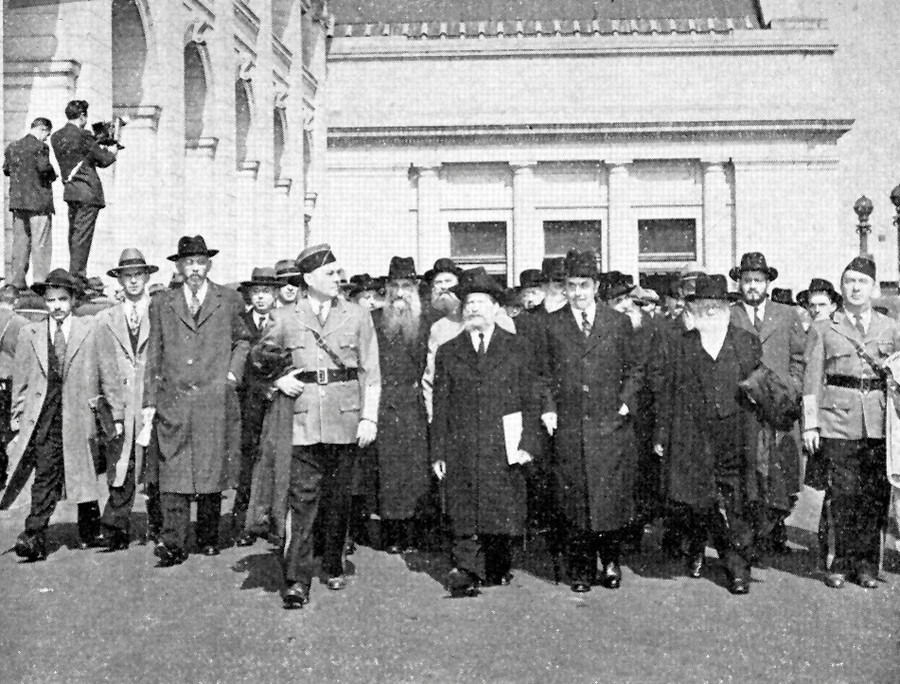Remembering a rabbi who marched
When I first invited Rav Binyomin Kamenetzky to speak about his participation in the 1943 march by rabbis in Washington, I assumed he had spoken about that episode on many previous occasions. I was startled to learn that, in fact, his address to the June 2007 national conference of the David S. Wyman Institute for Holocaust Studies would be the first time he had ever publicly addressed the topic.
Rav Kamenetzky, like all of the other marchers whom I have interviewed, assumed that the protest had been a failure. After all, President Franklin D. Roosevelt had refused to meet with the rabbis. Their petition was handed off to a low level staff member. Mainstream Jewish leaders publicly disparaged the march as a “stunt.” And the Bergson Group and the Va’ad ha-Hatzala, which organized the march, were dismissed as radicals and troublemakers.
I was honored to be the bearer of good news. I explained to the rav that recent research had found the march accomplished much more than he and his fellow-marchers had realized. The rabbis’ high-profile protest helped galvanize members of Congress to press the Roosevelt administration for action to rescue Europe’s Jews.
It was that crucial congressional pressure, combined with protests by the Bergson Group and behind-the-scenes efforts by Treasury Department officials, which compelled President Roosevelt to establish the War Refugee Board — exactly the step that the rabbis had urged in their petition.
During the final 15 months of the war, the Board helped save more than 200,000 refugees. It did so by bribing Nazi officials, financing the sheltering of refugees, and sending emissaries (including Raoul Wallenberg) into occupied Europe to rescue Jews. The War Refugee Board’s efforts confirmed the principle at the heart of the rabbis’ march — that if the U.S. government showed the will, ways would be found to rescue people.
By leaving their pulpits and yeshivas and traveling to Washington that day, these rabbis had, without realizing it, played an important part in a process that ultimately led to the saving of lives.
Rav Kamenetzky’s remarks at the 2007 Wyman Institute conference, held at the Fordham University School of Law, moved many in the audience to tears.
“I remember so well that morning, when we went, when the group of rabbis were walking from Union Station [the train terminal in Washington],” he said. “The tears started to roll down my face when I saw an elderly rebbe, holding on to a cane and crying, as we stood there on the steps of the Capitol. I shivered when I heard the Melitzer Rebbe reciting the Kel Maleh Rachamim. And the words spoken by Rabbi Eliezer Silver still ring in my ears — his proclamation demanding the rescue of our brothers, our sisters, in Europe.”
Why is it, Rav Kamenetzky asked, that the Torah commandment to remember what the Amalekites did to the Jews in ancient times not only commands “Remember,” but also concludes with the words “Never forget”? Aren’t those final two words superfluous?
“The problem,” the rav explained, “is that human beings were created with the ability to forget, and we do forget. Forgetfulness is an ailment. Some politicians forget what they said just the previous day. Which is why the Torah has to specifically instruct us not to forget.”
Connecting that point to contemporary events, he said it was imperative for today’s Jewish community “to never forget that when the leaders of Iran threaten to destroy the six million Jews in Israel, we have to do something about it.”
Practicing what he preached, Rav Kamenetzky approached me even before the conference ended and asked, “What can I do to help?” He knew that the Wyman Institute had been trying, without success, to persuade the United States Holocaust Memorial Museum, in Washington, and Yad Vashem, in Jerusalem, to add the rabbis’ march to their exhibits.
The rav was, at that point, 84 years old. Yet he was determined to actively assist the Institute’s campaign. And he did. Over the next several years, he personally recruited dozens of rabbis to sign our petitions calling for recognition of the march. One of those petitions was signed, fittingly, by 400 rabbis.
It took years, and many pleas and protests, but eventually the U.S. Holocaust Memorial Museum did add a photograph of the march to its permanent exhibit. I was glad to be the one to call Rav Kamenetzky to share that good news. We both lamented the fact that Yad Vashem, by contrast, still does not acknowledge the march. Hopefully Rav Kamenetzky’s example of activism will inspire others to carry on the good fight.
Dr. Rafael Medoff is founding director of the David S. Wyman Institute for Holocaust Studies, and author or editor of 16 books about Jewish history and the Holocaust.

 47.0°,
Fair
47.0°,
Fair 




